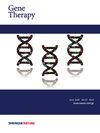氧化亚氮增强核磁共振引导的聚焦超声基因治疗递送到小鼠海马。
IF 4.5
3区 医学
Q1 BIOCHEMISTRY & MOLECULAR BIOLOGY
引用次数: 0
摘要
经颅磁共振引导的聚焦超声可以振荡静脉注射微泡,并在目标脑区域短暂打开血脑屏障(BBB)。然而,高微泡剂量或聚焦超声压力(FUS)会导致损伤。因此,我们给予一氧化二氮(N2O),一种麻醉气体来确定打开血脑屏障所需的FUS压力和微泡剂量的减少。用N2O或医用空气(MA)在不同的FUS压力下处理Swiss Webster小鼠,微泡剂量保持不变,反之亦然。因此,通过声发射和t1加权mr上的增强率来量化血脑屏障的开放程度。为了比较N2O对基因传递的影响,在用MA或N2O打开血脑屏障后,随后传递表达GFP的病毒载体。此外,免疫组织化学研究量化了病毒转染的效果并评估了急性细胞损伤。我们观察到,在所有测量压力(0.39,0.45,0.67 MPa)下,与MA相比,N2O显著增强了声发射和磁共振成像后图像的增强率。此外,N2O可将破坏血脑屏障的微泡剂量降低至0.02μl/kg,将FUS压力降低至0.28和0.39 MPa,从而增强病毒基因的传递。因此,N2O增强了微泡振荡,降低了微泡剂量和FUS压力,改善了病毒基因传递。本文章由计算机程序翻译,如有差异,请以英文原文为准。

Nitrous oxide enhances MR-guided focused ultrasound delivery of gene therapy to the murine hippocampus
Transcranial Magnetic Resonance Guided Focused Ultrasound can oscillate intravenously delivered microbubbles and transiently open the blood brain barrier (BBB) in a targeted brain region. However, high microbubble doses or Focused ultrasound pressures (FUS) leads to injury. So, we administered nitrous oxide (N2O), an anesthetic gas to determine reduced need of FUS pressure and microbubble dose for opening BBB. Swiss Webster mice were treated with N2O or medical air (MA) at varying FUS pressures, while the microbubble dose was kept constant and the vice-versa. Consequently, BBB opening was quantified by acoustic emissions and enhancement rate on T1-weighted MR. To compare the effect of N2O on gene delivery, following BBB opening with either MA or N2O, a viral vector expressing GFP was subsequently delivered. Additionally, Immunohistochemical studies quantified viral transfection efficacy and assessed acute cell injury. We observed that N2O significantly potentiates acoustic emissions and enhancement rate on post-contrast MRI images, compared to MA at all measured pressures (0.39, 0.45, 0.67 MPa). Furthermore, N2O reduces the microbubble dose to 0.02μl/kg and FUS pressures to 0.28 and 0.39 MPa for BBB disruption and enhanced viral gene delivery, respectively. Hence, N2O potentiates microbubble oscillations, allowing reduced microbubble dose and FUS pressures and improved viral gene delivery.
求助全文
通过发布文献求助,成功后即可免费获取论文全文。
去求助
来源期刊

Gene Therapy
医学-生化与分子生物学
CiteScore
9.70
自引率
2.00%
发文量
67
审稿时长
4-8 weeks
期刊介绍:
Gene Therapy covers both the research and clinical applications of novel therapeutic techniques based on a genetic component. Over the last few decades, significant advances in technologies ranging from identifying novel genetic targets that cause disease through to clinical studies, which show therapeutic benefit, have elevated this multidisciplinary field to the forefront of modern medicine.
 求助内容:
求助内容: 应助结果提醒方式:
应助结果提醒方式:


